Trinity College Dublin: Difference between revisions
Created page with "{{Infobox college |name=Trinity College |full_name=The College of the Holy and Undivided Trinity of Queen Elizabeth near Dublin |university=Dublin |county=Dublin |city=Dublin..." |
No edit summary |
||
| (3 intermediate revisions by the same user not shown) | |||
| Line 1: | Line 1: | ||
{{Infobox college | {{Infobox college | ||
|name=Trinity College | |name=Trinity College | ||
| | |full name=The College of the Holy and Undivided Trinity<br>of Queen Elizabeth near Dublin | ||
|university=Dublin | |university=Dublin | ||
|county=Dublin | |county=Dublin | ||
|city=Dublin | |city=Dublin | ||
|picture=ImeldaCasey TrinityatNight.jpg | |picture=ImeldaCasey TrinityatNight.jpg | ||
|picture caption=The Campanile and Parliament | |picture caption=The Campanile and Parliament Square | ||
|os grid ref=O16073408 | |os grid ref=O16073408 | ||
|latitude=53.3444 | |latitude=53.3444 | ||
| Line 14: | Line 14: | ||
|founded=1592 | |founded=1592 | ||
|architect= | |architect= | ||
|principal title=Provost | |||
|style= | |style= | ||
|livery=000066 | |livery=000066 | ||
|students=11,718 (2016-17) | |students=11,718 (2016-17) | ||
|website=http://www.tcd.ie | |website=[http://www.tcd.ie www.tcd.ie] | ||
}} | }} | ||
'''Trinity College''', officially the '''College of the Holy and Undivided Trinity of Queen Elizabeth near Dublin''', is the sole constituent college of the [[University of Dublin]], a research university in [[Dublin]]. The college was founded in 1592 by Queen Elizabeth I]] as "the mother of a university" after the pattern of the collegiate universities of [[University of Oxford|Oxford]] and [[University of Cambridge|Cambridge]], but unlike these institutions, only one college was ever established. As such, the designations "Trinity College" and "University of Dublin" are usually synonymous for practical purposes.<ref>https://www.tcd.ie/about/content/history_index-backup190313.php</ref> The college is legally incorporated by "the Provost, Fellows, Foundation Scholars and other members of the Board," as outlined by its founding charter.<ref>{{cite web|url=https://www.tcd.ie/Secretary/corporate/legal-faq/|title=TCD Corporate and Legal FAQ|date=30 May 2018|website=www.tcd.ie}}</ref> | '''Trinity College''', officially the '''College of the Holy and Undivided Trinity of Queen Elizabeth near Dublin''', is the sole constituent college of the [[University of Dublin]], a research university in [[Dublin]]. The college was founded in 1592 by Queen Elizabeth I]] as "the mother of a university" after the pattern of the collegiate universities of [[University of Oxford|Oxford]] and [[University of Cambridge|Cambridge]], but unlike these institutions, only one college was ever established. As such, the designations "Trinity College" and "University of Dublin" are usually synonymous for practical purposes.<ref>https://www.tcd.ie/about/content/history_index-backup190313.php</ref> The college is legally incorporated by "the Provost, Fellows, Foundation Scholars and other members of the Board," as outlined by its founding charter.<ref>{{cite web|url=https://www.tcd.ie/Secretary/corporate/legal-faq/|title=TCD Corporate and Legal FAQ|date=30 May 2018|website=www.tcd.ie}}</ref> | ||
| Line 24: | Line 24: | ||
This is one of the seven ancient universities of Britain and Ireland,<ref name=h15>{{cite book|author=Sarah Hutton|title=British Philosophy in the Seventeenth Century|url=https://books.google.com/books?id=c_wJCAAAQBAJ&pg=PA27|date=15 May 2015|publisher=Oxford University Press|isbn=978-0-19-958611-0|pages=27–}}</ref> as well as Ireland's oldest surviving university.<ref>{{cite book|last=Grabham|first=Sue|date=1995|chapter=Republic of Ireland Introduction|title=Encyclopedia of Lands & Peoples|publisher=Kingfisher|location=London|page=39|isbn=1-85697-292-5}}</ref> | This is one of the seven ancient universities of Britain and Ireland,<ref name=h15>{{cite book|author=Sarah Hutton|title=British Philosophy in the Seventeenth Century|url=https://books.google.com/books?id=c_wJCAAAQBAJ&pg=PA27|date=15 May 2015|publisher=Oxford University Press|isbn=978-0-19-958611-0|pages=27–}}</ref> as well as Ireland's oldest surviving university.<ref>{{cite book|last=Grabham|first=Sue|date=1995|chapter=Republic of Ireland Introduction|title=Encyclopedia of Lands & Peoples|publisher=Kingfisher|location=London|page=39|isbn=1-85697-292-5}}</ref> | ||
Trinity College is the most prestigious university in Ireland,<ref>{{Cite web|url=https://www.tcd.ie/study/international/why-trinity/|title=Why Trinity? - Study - Trinity College Dublin}}</ref> and one of the most elite academic institutions in Europe.<ref>{{Cite web|url=https://www.universitytimes.ie/2015/09/trinity-and-age-old-elitism/|title=Trinity and Age-Old Elitism|website=www.universitytimes.ie}}</ref> The college is particularly acclaimed in the fields of Law, Literature and Humanities.<ref>{{Cite web|url=http://cultural-opposition.eu/partners/trinity-college-dublin-ireland/|title=Trinity College, Dublin - Courage – Connecting collections|website=cultural-opposition.eu}}</ref> In accordance with the formula of ''ad eundem gradum'', a form of recognition that exists among the University of Oxford, the University of Cambridge and the University of Dublin, a graduate of Oxford, Cambridge, or Dublin can be conferred with the | Trinity College is the most prestigious university in Ireland,<ref>{{Cite web|url=https://www.tcd.ie/study/international/why-trinity/|title=Why Trinity? - Study - Trinity College Dublin}}</ref> and one of the most elite academic institutions in Europe.<ref>{{Cite web|url=https://www.universitytimes.ie/2015/09/trinity-and-age-old-elitism/|title=Trinity and Age-Old Elitism|website=www.universitytimes.ie}}</ref> The college is particularly acclaimed in the fields of Law, Literature and Humanities.<ref>{{Cite web|url=http://cultural-opposition.eu/partners/trinity-college-dublin-ireland/|title=Trinity College, Dublin - Courage – Connecting collections|website=cultural-opposition.eu}}</ref> In accordance with the formula of ''ad eundem gradum'', a form of recognition that exists among the University of Oxford, the University of Cambridge and the University of Dublin, a graduate of Oxford, Cambridge, or Dublin can be conferred with the equivalent degree at either of the other two universities without further examination.<ref>{{cite book|url=http://www.admin.ox.ac.uk/statutes/|title=Statutes and Regulations, University of Oxford|chapter=Statute X: Degrees, Diplomas, and Certificates|chapter-url=http://www.admin.ox.ac.uk/statutes/215-031.shtml}}</ref> Trinity College, Dublin is a sister college to [[St John's College, Cambridge]] and [[Oriel College, Oxford]]. | ||
Originally, Trinity was established in [[County Dublin]] but outside the city walls of Dublin in the buildings of the outlawed Roman Catholic Augustinian Priory of All Hallows. Trinity College was set up in part to consolidate the rule of the Tudor monarchy in Ireland, and as a result was the university of the Protestant Ascendancy for much of its history.<ref>{{cite book|url=https://books.google.com/books?id=QE-P0ffkTUoC&q=1566+University+of+Dublin&pg=PA44|title=Charters of Foundation and Early Documents of the Universities of the Coimbra Group|first1=Jos M. M.|last1=Hermans|first2=Marc|last2=Nelissen|date=21 January 2018|publisher=Leuven University Press|access-date=21 January 2018|via=Google Books|isbn=9789058674746}}</ref> While Roman Catholics were admitted from 1793, certain restrictions on membership of the college remained, as professorships, fellowships and scholarships were reserved for Protestants. These restrictions were lifted by an Act of Parliament in 1873.<ref>{{cite web|url=http://hansard.millbanksystems.com/commons/1834/may/08/catholics-and-trinity-college-dublin|title=Catholics and Trinity College, Dublin. (Hansard, 8 May 1834)|website=Hansard.millbanksystems.com}}</ref> However, from 1871 to 1970, the Roman Catholic Church in Ireland, in turn, forbade its adherents from attending Trinity College without permission. | Originally, Trinity was established in [[County Dublin]] but outside the city walls of Dublin in the buildings of the outlawed Roman Catholic Augustinian Priory of All Hallows. Trinity College was set up in part to consolidate the rule of the Tudor monarchy in Ireland, and as a result was the university of the Protestant Ascendancy for much of its history.<ref>{{cite book|url=https://books.google.com/books?id=QE-P0ffkTUoC&q=1566+University+of+Dublin&pg=PA44|title=Charters of Foundation and Early Documents of the Universities of the Coimbra Group|first1=Jos M. M.|last1=Hermans|first2=Marc|last2=Nelissen|date=21 January 2018|publisher=Leuven University Press|access-date=21 January 2018|via=Google Books|isbn=9789058674746}}</ref> While Roman Catholics were admitted from 1793, certain restrictions on membership of the college remained, as professorships, fellowships and scholarships were reserved for Protestants. These restrictions were lifted by an Act of Parliament in 1873.<ref>{{cite web|url=http://hansard.millbanksystems.com/commons/1834/may/08/catholics-and-trinity-college-dublin|title=Catholics and Trinity College, Dublin. (Hansard, 8 May 1834)|website=Hansard.millbanksystems.com}}</ref> However, from 1871 to 1970, the Roman Catholic Church in Ireland, in turn, forbade its adherents from attending Trinity College without permission. | ||
Latest revision as of 22:52, 15 January 2021
| Trinity College
| |
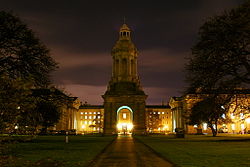 The Campanile and Parliament Square | |
|---|---|
 | |
| Founded: | 1592 by Queen Elizabeth I |
| Provost: | |
| No. of students: | 11,718 (2016-17) |
| Website: | www.tcd.ie |
| Location | |
| Grid reference: | O16073408 |
| Location: | 53°20’40"N, 6°15’28"W |
Trinity College, officially the College of the Holy and Undivided Trinity of Queen Elizabeth near Dublin, is the sole constituent college of the University of Dublin, a research university in Dublin. The college was founded in 1592 by Queen Elizabeth I]] as "the mother of a university" after the pattern of the collegiate universities of Oxford and Cambridge, but unlike these institutions, only one college was ever established. As such, the designations "Trinity College" and "University of Dublin" are usually synonymous for practical purposes.[1] The college is legally incorporated by "the Provost, Fellows, Foundation Scholars and other members of the Board," as outlined by its founding charter.[2]
This is one of the seven ancient universities of Britain and Ireland,[3] as well as Ireland's oldest surviving university.[4]
Trinity College is the most prestigious university in Ireland,[5] and one of the most elite academic institutions in Europe.[6] The college is particularly acclaimed in the fields of Law, Literature and Humanities.[7] In accordance with the formula of ad eundem gradum, a form of recognition that exists among the University of Oxford, the University of Cambridge and the University of Dublin, a graduate of Oxford, Cambridge, or Dublin can be conferred with the equivalent degree at either of the other two universities without further examination.[8] Trinity College, Dublin is a sister college to St John's College, Cambridge and Oriel College, Oxford.
Originally, Trinity was established in County Dublin but outside the city walls of Dublin in the buildings of the outlawed Roman Catholic Augustinian Priory of All Hallows. Trinity College was set up in part to consolidate the rule of the Tudor monarchy in Ireland, and as a result was the university of the Protestant Ascendancy for much of its history.[9] While Roman Catholics were admitted from 1793, certain restrictions on membership of the college remained, as professorships, fellowships and scholarships were reserved for Protestants. These restrictions were lifted by an Act of Parliament in 1873.[10] However, from 1871 to 1970, the Roman Catholic Church in Ireland, in turn, forbade its adherents from attending Trinity College without permission.
Women were first admitted to the college as full members in January 1904.[11]
Trinity College is now surrounded by central Dublin and is located on College Green, opposite the historic Irish Houses of Parliament. The college campus is often ranked among the most beautiful university campuses in the world, primarily due to its Georgian architecture buildings.[12] The college proper occupies 190,000 m2 (47 acres), with many of its buildings ranged around large quadrangles (known as 'squares') and two playing fields. Academically, it is divided into three faculties comprising 25 schools, offering degree and diploma courses at both undergraduate and postgraduate levels. The university is globally recognised as a leading international centre for research and also as a world leader in Nanotechnology, Information Technology, Immunology, Mathematics, Engineering, Psychology, Politics, English and Humanities.[13] The admission procedure is highly competitive, and based exclusively on academic merit.[14]
The Library of Trinity College is a legal deposit library for Ireland and Great Britain, containing around 7 million printed volumes and significant quantities of manuscripts, including the renowned Book of Kells, which arrived at the college in 1661 for safekeeping after the Cromwellian raids on religious institutions.[15] The enormous collection housed in the Long Room includes a rare copy of the 1916 Proclamation of the Irish Republic and a 15th-century wooden harp which is the model for the current emblem of Ireland. The library itself receives over half a million visitors each year, making it the most important one in Ireland.[16]
History
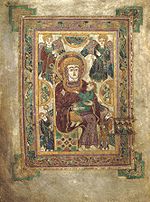
Early history
The first University of Dublin (known as the Mediæval University of Dublin and unrelated to the current university) was created by Pope Clement V|the Pope in 1311,[17] and had a Chancellor, lecturers and students (granted protection by the Crown) over many years, before coming to an end at the Reformation.
Following this, and some debate about a new university at St Patrick's Cathedral, in 1592 a small group of Dublin citizens obtained a charter by way of letters patent from Queen Elizabeth.
The first provost of the college was the Archbishop of Dublin, Adam Loftus, who had ensured it was named 'Trinity' after Trinity College, Cambridge, his former college at the University of Cambridge. Two years after foundation, a few Fellows and students began to work in the new college, which then lay around one small square.
During the following fifty years the community increased the endowments, including considerable landed estates, were secured, new fellowships were founded, the books which formed the foundation of the great library were acquired, a curriculum was devised and statutes were framed. The founding Letters Patent were amended by succeeding monarchs on a number of occasions, such as by James I in 1613 and most notably in 1637 by Charles I (who increased the number of fellows from seven to sixteen, established the Board – then the Provost and the seven senior Fellows – and reduced the panel of Visitors in size) and supplemented as late as the reign of Queen Victoria (and later still amended by the Oireachtas in 2000).[18]
18th and 19th centuries
During the eighteenth century Trinity College was seen as the university of the Protestant Ascendancy. The Irish Parliament, meeting on the other side of College Green, made generous grants for building. The first building of this period was the Old Library building, begun in 1712, followed by the Printing House and the Dining Hall. During the second half of the century, Parliament Square slowly emerged. The great building drive was completed in the early nineteenth century by Botany Bay, the square which derives its name in part from the herb garden it once contained (and which was succeeded by Trinity College's own Botanic Gardens). Following early steps in relief, Roman Catholics were first allowed to apply for admission in 1793,[19] before the equivalent change at the University of Cambridge and the University of Oxford. Certain disabilities remained. In December 1845 Denis Caulfield Heron was the subject of a hearing at Trinity College. Heron had previously been examined and, on merit, declared a scholar of the college but had not been allowed to take up his place due to his Roman religion. Heron appealed to the Courts which issued a writ of mandamus requiring the case to be adjudicated by the Archbishop of Dublin and the Archbishop of Armagh.[20] The decision of Richard Whately and John George de la Poer Beresford was that Heron would remain excluded from Scholarship.[21] This decision confirmed that the legal position remained that persons who were not Anglicans could not be elected to Scholarship, Fellowship or be made a Professor. However within less than three decades of this, all disabilities imposed on Roman Catholics were repealed as in 1873, all religious tests were abolished, except for entry to the divinity school. However, the Irish Roman Catholic bishops responding to the increased ease, due to these changes, with which Catholics could attend an Institution which the Bishops saw as thoroughly Protestant in ethos, and in light of the establishment of the Catholic University of Ireland, in 1871 implemented a general ban on Catholics entering Trinity College, with few exceptions. "The ban" was rescinded by the Roman Catholic Bishops of Ireland in 1970.
The nineteenth century was also marked by important developments in the professional schools. The law school was reorganised after the middle of the century. Medical teaching had been given in the college since 1711, but it was only after the establishment of the school on a firm basis by legislation in 1800, and under the inspiration of one Macartney, that it was in a position to play its full part, with such teachers as Graves and Stokes, in the great age of Dublin medicine. The Engineering School was established in 1842 and was one of the first of its kind in Ireland and Britain.
In April 1900, Queen Victoria visited College Green in Dublin.[22]
20th century
Women were admitted to Trinity College as full members for the first time in 1904. For the period from 1904 to 1907, women from Oxford and Cambridge came to Trinity College to receive their ad eundem degree and were known as Steamboat ladies.
In 1907, the Chief Secretary for Ireland proposed the reconstitution of the University of Dublin. A "Dublin University Defence Committee" was created and was successful in campaigning against any change to the status quo, while the Roman Catholic bishops' rejection of the idea ensured its failure among the Catholic population. Chief among the concerns of the bishops was the remains of the Catholic University of Ireland, which would become subsumed into a new university, which on account of Trinity College would be part Anglican. Ultimately this episode led to the creation of the National University of Ireland.
Trinity College was one of the targets of the Volunteer and Citizen Army forces during the 1916 Easter Rising but was successfully defended by a small number of unionist students,[23] most of whom were members of the university Officers' Training Corps. From July 1917 until March 1918 the Irish Convention met in the college in an attempt to address the political aftermath of the Easter rising. (Subsequently, following the failure of the Convention to reach "substantial agreement", the Irish Free State was set up in 1922.) In the post-independence period Trinity College suffered from a cool relationship with the new state. On 3 May 1955 the Provost, Dr A.J. McConnell, pointed out in a piece in the Irish Times that certain state-funded County Council scholarships excluded Trinity College from the list of approved institutions. This, he suggested, amounted to religious discrimination, which was forbidden by the constitution.

The School of Commerce was established in 1925, and the School of Social Studies in 1934. Also in 1934, the first female professor was appointed.
1958 saw the first Roman Catholic to reach the Board of Trinity as a Senior Fellow.
In 1962 the School of Commerce and the School of Social Studies amalgamated to form the School of Business and Social Studies. In 1969 the several schools and departments were grouped into Faculties as follows: Arts (Humanities and Letters); Business, Economic and Social Studies; Engineering and Systems Sciences; Health Sciences (since October 1977 all undergraduate teaching in dental science in the Dublin area has been located in Trinity College); Science.
In 1970 the Roman Catholic Church lifted its ban on its members attending the college without special dispensation. At the same time, the Trinity College authorities invited the appointment of a Roman Catholic chaplain to be based in the college.[24]
In the late 1960s, there was a proposal for University College, Dublin, of the National University of Ireland, to become a constituent college of a newly reconstituted University of Dublin. This plan was dropped after opposition by Trinity College students.
From 1975, the Colleges of Technology that now form the Dublin Institute of Technology had their degrees conferred by the University of Dublin. This arrangement was discontinued in 1998 when the DIT obtained degree-granting powers of its own.
The School of Pharmacy was established in 1977 and around the same time, the Faculty of Veterinary Medicine was transferred to University College, Dublin in exchange for its Dental School. Student numbers increased sharply during the 1980s and 1990s, with total enrolment more than doubling, leading to pressure on resources and subsequent investment programme.
In 1991, Thomas Noel Mitchell became the first Roman Catholic elected Provost of Trinity College.[25]
21st century
Trinity College is today in the centre of Dublin. At the beginning of the new century, it embarked on a radical overhaul of academic structures to reallocate funds and reduce administration costs, resulting in, for instance, the mentioned reduction from six to five to eventually three faculties under a subsequent restructuring by a later governing authority. The ten-year strategic plan prioritises four research themes with which the college seeks to compete for funding at the global level. Comparative funding statistics reviewing the difference in departmental unit costs and overall costs before and after this restructuring are not however apparent.[26] The Hamilton Mathematics Institute in Trinity College, named in honour of William Rowan Hamilton, was launched in 2005 and aims to improve the international profile of Irish mathematics, to raise public awareness of mathematics and to support local mathematical research through workshops, conferences and a visitor programme.
Buildings and grounds
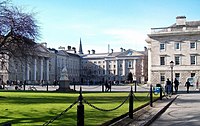
Trinity College retains a tranquil collegiate atmosphere despite its location in the centre of a capital city (and despite its being one of the most significant tourist attractions in Dublin). This is, in large part, due to the compact design of the college, whose main buildings look inwards and are arranged in large quadrangles (called squares), and the existence of only a few public entrances.
The main college grounds are approximately 47 acres, including the Trinity College Enterprise Centre nearby, and buildings account for around 50 acres, ranging from works of older architecture to more modern buildings. The main entrance to the college is on the College Green, and its grounds are bounded by Nassau and Pearse Streets. The college is bisected by College Park, which has a cricket and rugby pitch.
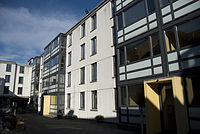
The western side of the college is older, featuring the Campanile, as well as many fine buildings, including the Chapel and Examination Hall (designed by Sir William Chambers), Graduates Memorial Building, Museum Building, and the The Rubrics|Rubrics, all spread across College's five squares. The Provost's House sits a little way up from the College Front Gate such that the House is actually on Grafton Street, one of the two principal shopping streets in the city, while its garden faces into the college. The Douglas Hyde Gallery, a contemporary art gallery, is located in the college as is the Samuel Beckett Theatre. It hosts national and international performances and is used by the Dublin International Theatre Festival, the Dublin Dance Festival, and The Fringe Festival, among others. During the academic term it is predominantly used as a teaching and performance space for Drama students and staff.
The eastern side of the college is occupied by Science buildings, most of which are modern developments, arranged in three rows instead of quadrangles. In 2010, Forbes ranked the it as one of the 15 most beautiful college grounds in the world.[27]
The college also incorporates a number of buildings and facilities spread throughout the city, from the Politics and Sociology Departments, located on Dame Street, to the Faculty of Health Sciences buildings, located at St. James's Hospital and Tallaght University Hospital. The Trinity Centre at St James's Hospital incorporates additional teaching rooms, as well as the Institute of Molecular Medicine and John Durkan Leukaemia Institute. The college also owns a large set of residences four kilometres to the south of the college on the Dartry Road, in Rathmines, called Trinity Hall.
In November 2018, the college announced plans, estimated at €230 million, to develop university research facilities on a site in Grand Canal Dock as part of an "Innovation District" for the area.[28]
Chapel
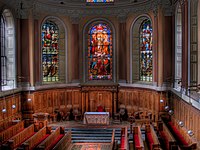
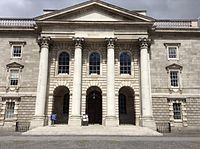
The current chapel was completed in 1798, and was designed by George III's architect, Sir William Chambers, who also designed the public theatre opposite the chapel on Parliament Square.[29] Reflecting the college's Anglican heritage, there are daily services of Morning prayer, weekly services of Evensong, and Holy Communion is celebrated on Tuesdays and Sundays. It is no longer compulsory for students to attend these.
The chapel has been ecumenical since 1970, and is now also used daily in the celebration of Mass for the Roman Catholic members of the college. In addition to the Anglican chaplain, who is known as the Dean of Residence, there are two Roman Catholic chaplains and one Methodist chaplain. Ecumenical events are often held in the chapel, such as the annual carol service and the service of thanksgiving on Trinity Monday.[30]
Library
- Main article: Trinity College Library
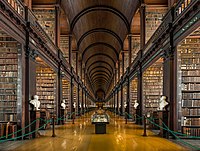
The Library of Trinity College is the largest research library in Ireland. As a result of its historic standing, Trinity College Library Dublin is a legal deposit library (as per Legal Deposit Libraries Act 2003) for the United Kingdom and has a similar standing in Irish law. The college is therefore legally entitled to a copy of every book published in Great Britain and Ireland and consequently receives over 100,000 new items every year. The library contains about five million books, including 30,000 current serials and significant collections of manuscripts, maps, and printed music. Three million books are held in the book depository, "Stacks", in Santry, from which requests are retrieved twice daily.
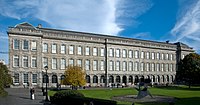
The Library proper is composed of several library buildings in college. The original (Old) Library is Thomas Burgh's masterpiece. A huge building, it originally towered over the university and city after its completion. Even today, surrounded by similarly scaled buildings, it is imposing and dominates the view of the university from Nassau Street. It was founded with the college and first endowed by James Ussher (1625–56), Archbishop of Armagh, who endowed his own valuable library, comprising several thousand printed books and manuscripts, to the college. The Book of Kells is by far the Library's most famous book and is located in the Old Library, along with the Book of Durrow, the Book of Howth and other ancient texts. Also incorporating the Long Room, the Old Library is one of Ireland's biggest tourist attractions and holds thousands of rare, and in many cases very early, volumes. In the 18th century, the college received the Brian Boru harp, one of the three surviving mediæval Gaelic harps, and a national symbol of Ireland, which is now housed in the library.
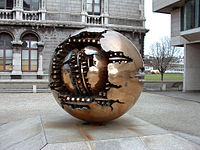
The buildings referred to as the college's BLU (Berkeley Lecky Ussher) Arts library complex consist of the Berkeley Library in Fellow's Square, built in 1956, the Lecky Library, attached to the Arts building, and the James Ussher Library which, opening officially in 2003, overlooks College Park and houses the Glucksman Map Library. The Glucksman Library contains half a million printed maps, the largest collection of cartographic materials in Ireland. This includes the first Ordnance Surveys of Ireland, conducted in the early 19th century.
The Library also includes the William Hamilton Science and Engineering Library and the John Stearne Medical Library, housed at St James's Hospital.
Research
Trinity College is the most productive internationally recognised research centre in Ireland. The university operates an Innovation Centre which fosters academic innovation and consultancy, provides patenting advice and research information and facilitates the establishment and operation of industrial laboratories and campus companies.
In 1999, the university purchased an Enterprise Centre on Pearse Street, seven minutes' walk from the on-site "Innovation Centre". The site has over 200,000 ft² of built space and contains a protected building, the Tower, which houses a Craft Centre. The Trinity Enterprise Centre houses companies drawn from the university research sector in Dublin.
Sport
There is a sporting tradition at Trinity and the college has 50 sports clubs affiliated to the Dublin University Central Athletic Club (DUCAC).[31]
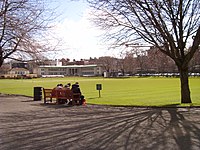
The Central Athletic Club is made up of five committees that oversee the development of sport in the college: the Executive Committee which is responsible overall for all activities, the Captains' Committee which represents the 49 club captains and awards University Colours (Pinks), the Pavilion Bar Committee which runs the private members' bar, the Pavilion Members' Committee and the Sports Facilities Committee.
The oldest clubs include:
- Dublin University Cricket Club (1835);
- Dublin University Boat Club (1836);
- Dublin University Rifle Club (1840)
Dublin University Football Club, founded in 1854, plays rugby union and is the world's oldest documented "football club". Dublin University A.F.C., founded in 1883, is the oldest surviving association football club in the Republic of Ireland.[32][33][34][35] The Dublin University Hockey Club was founded in 1893. The Dublin University Harriers and Athletic Club was founded in 1885.[36]
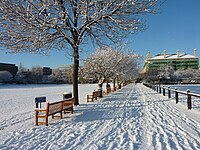
The newest club in the university is the American football team, who were accepted into the Irish American Football League (IAFL) in 2008. Initially known as the Trinity Thunderbolts, the club now competes under the name "Trinity College". The most successful Trinity College sports club – based on Intervarsities victories – is Dublin University Fencing Club (DU Fencing Club). A total of forty-one Intervarsity titles have been won by the club in sixty-four years of competition. While the modern DU Fencing Club was founded in 1936, its origins can be dated to the 1700s when a 'Gentleman's Club of the Sword' existed, primarily for duelling practice.[37] There are several graduate sport clubs that exist separate to the Central Athletic Club including the Dublin University Museum Players (cricket), the Lady Elizabeth Boat Club (rowing) and the Mary Lyons Memorial Mallets (croquet).
Traditions and culture
Commons
Commons is a three course meal served in the College Dining Hall Monday to Friday, attended by Scholars and Fellows and Sizars of the college, as well as other members of the college community and their guests.
Commons starts at 18:15 during the week, and its start is signalled by a dramatic slamming of the Dining Hall doors. The bell of the Campanile in the college is rung at 18:00 to inform those attending the dinner.
A Latin Grace is said "before and after dinner", read by one of the scholars.
| Grace | Latin | English |
|---|---|---|
| Ante Prandium (Before Dinner) |
Oculi omnium in te sperant Domine. Tu das iis escam eorum in tempore opportuno. Aperis tu manum tuam, et imples omne animal benedictione tua. Miserere nostri te quaesumus Domine, tuisque donis, quae de tua benignitate sumus percepturi, benedicito per Christum Dominum nostrum. | The eyes of all hope in thee, O Lord. Thou givest them meat in due season. Thou openest thy hand, and fillest with blessing every living creature. Have mercy on us, we beseech thee, O Lord, and bless thy gifts, which from thy kindness we are about to receive, through Christ our Lord. |
| Post Prandium (After Dinner) |
Tibi laus, tibi honor, tibi gloria, O beata et gloriosa Trinitas. Sit nomen Domini benedictum et nunc et in perpetuum. Laudamus te, benignissime Pater, pro serenissimis, regina Elizabetha hujus Collegii conditrice, Jacobo ejusdem munificentissimo auctore, Carolo conservatore, ceterisque benefactoribus nostris, rogantes te, ut his tuis donis recte et ad tuam gloriam utentes in hoc saeculo, te una cum fidelibus in futuro feliciter perfruamur, per Christum Dominum nostrum. | To thee be praise, to thee be honour, to thee be glory, O blessed and glorious Trinity. Blessed be the name of the Lord now and forever. We praise thee, most gracious Father, for the most serene ones, Queen Elizabeth the foundress of this college, James its most munificent builder, Charles its preserver, and our other benefactors. Asking thee, as we make use of these thy gifts rightly and for thy glory at this time, that we might exalt in thee together with the faithful happily in the future, through Christ our Lord. |
During Advent, members of the Chapel Choir sing Christmas Carols to accompany the meals.
Trinity Week
Each year, Trinity Week is celebrated in mid-April on Trinity Monday and on the afternoon of Trinity Wednesday no lectures or demonstrations are held. College races are held each year on Trinity Wednesday.
The start of Trinity Week is marked by the election of Fellows and Scholars to the College on Trinity Monday. The board of the college, having chosen the new Scholars (those who achieved a First in the Foundation Scholarship) and Fellows,[38] announce in front square those appointed, before an ecumenical service is held in the College Chapel, with music sung by the Chapel Choir.
Other traditions
There is a long-standing rivalry with nearby University College Dublin, which is largely friendly in nature. Every year, Colours events are contested between the sporting clubs of each University.
Most students of the college (undergraduates especially) never walk underneath the Campanile, as the tradition suggests that should the bell ring whilst they pass under it, they will fail their annual examinations. This is negated only if they touch the foot of the statue of George Salmon within five seconds of the bell ringing.
References
- ↑ https://www.tcd.ie/about/content/history_index-backup190313.php
- ↑ "TCD Corporate and Legal FAQ". 30 May 2018. https://www.tcd.ie/Secretary/corporate/legal-faq/.
- ↑ Sarah Hutton (15 May 2015). British Philosophy in the Seventeenth Century. Oxford University Press. pp. 27–. ISBN 978-0-19-958611-0. https://books.google.com/books?id=c_wJCAAAQBAJ&pg=PA27.
- ↑ Grabham, Sue (1995). "Republic of Ireland Introduction". Encyclopedia of Lands & Peoples. London: Kingfisher. p. 39. ISBN 1-85697-292-5.
- ↑ "Why Trinity? - Study - Trinity College Dublin". https://www.tcd.ie/study/international/why-trinity/.
- ↑ "Trinity and Age-Old Elitism". https://www.universitytimes.ie/2015/09/trinity-and-age-old-elitism/.
- ↑ "Trinity College, Dublin - Courage – Connecting collections". http://cultural-opposition.eu/partners/trinity-college-dublin-ireland/.
- ↑ "Statute X: Degrees, Diplomas, and Certificates". Statutes and Regulations, University of Oxford. http://www.admin.ox.ac.uk/statutes/215-031.shtml.
- ↑ Hermans, Jos M. M.; Nelissen, Marc (21 January 2018). Charters of Foundation and Early Documents of the Universities of the Coimbra Group. Leuven University Press. ISBN 9789058674746. https://books.google.com/books?id=QE-P0ffkTUoC&q=1566+University+of+Dublin&pg=PA44. Retrieved 21 January 2018.
- ↑ "Catholics and Trinity College, Dublin. (Hansard, 8 May 1834)". http://hansard.millbanksystems.com/commons/1834/may/08/catholics-and-trinity-college-dublin.
- ↑ Robert Brendan McDowell; David Allardice Webb (1982). Trinity College, Dublin, 1592–1952: An Academic History. Cambridge University Press. ISBN 978-0-521-23931-8. https://books.google.com/books?id=_QC7AAAAIAAJ.
- ↑ https://www.thetravel.com/prettiest-college-campuses-in-the-world/
- ↑ Catherine, Fanning. "Trinity College Dublin - The University of Dublin" (in en). https://www.educationinireland.com/en/where-can-i-study-/view-all-universities-colleges/trinity-college-dublin-introduction.html.
- ↑ "Entry Requirements for International Students - Study - Trinity College Dublin". https://www.tcd.ie/study/international/how-to-apply/entry-requirements.php.
- ↑ "The Long Room Library at Trinity College" (in en). http://www.atlasobscura.com/places/the-long-room-library.
- ↑ "History of the Library - The Library of Trinity College Dublin - Trinity College Dublin". https://www.tcd.ie/library/about/history.php.
- ↑ London: Newman, Cardinal Henry; The Rise and Progress of Universities, Chapter 17 (The Ancient University of Dublin), 207–212
- ↑ "Legal FAQ - Secretary's Office - Trinity College Dublin". https://www.tcd.ie/Secretary/corporate/legal-faq/.
- ↑ Catholic Relief Act, 1793, section 13
- ↑ The Times, Important Collegiate Question., Denis C. Heron 13 December 1845; pg3 col E
- ↑ The Times; Ireland. Protestant Alliance; 9 January 1846; pg5 col D
- ↑ L'Estrange, Robert Augustus Henry (1900). "Queen Victoria's Royal visit to Dublin, Ireland, 4th April - 26th April, 1900" (in en). https://digitalcollections.qut.edu.au/4115/.
- ↑ "Soldiers are we" by Charles Townshend, History Today, 1 April 2006, p163-164
- ↑ McCarthy, Eamonn (22 January 2000). "Soline Vatinel, The Archbishop and Me". B.A.S.I.C. Brothers and Sisters in Christ Praying and Working for the Ordination of Women in the Roman Catholic Church. http://www.iol.ie/~duacon/nl19-3.htm.
- ↑ Dublin, Provost & President, Trinity College. "Thomas Noel Mitchell - Provost & President : Trinity College Dublin". http://www.tcd.ie/provost/history/former-provosts/tn_mitchell.php.
- ↑ "TCD Strategic Plan 2006". http://www.tcd.ie/about/content/pdf/TCDStrategicPlan2006_English.pdf.
- ↑ "The World's Most Beautiful College Campuses". Forbes. https://www.forbes.com/2010/08/31/beautiful-campuses-lifestyle-education-colleges-10-university-architecture_slide_7.html.
- ↑ Kennedy, John (2018-11-22). "Trinity College Dublin reveals €230m blueprint for the campus of the future" (in en). https://www.siliconrepublic.com/innovation/trinity-college-campus-future-estates-strategy.
- ↑ Dublin, New Website, Trinity College. "History - About Trinity : Trinity College Dublin". http://www.tcd.ie/about/history/.
- ↑ "Chaplaincy - Trinity College Dublin". http://www.tcd.ie/Chaplaincy/.
- ↑ "DUCAC – Trinity Sport – Trinity College Dublin". 24 June 2020. https://www.tcd.ie/Sport/student-sport/clubs/.
- ↑ Byrne, Peter (1996). Football Association of Ireland: 75 years. Dublin: Sportsworld. ISBN 1-900110-06-7.
- ↑ Garnham, Neal (2004). Association Football and society in pre-partition Ireland. Belfast: Ulster Historical Foundation. ISBN 1-903688-34-5.
- ↑ Byrne, Peter (2012). Green Is The Colour: The Story of Irish Football. Andre Deutsch.
- ↑ The Bold Collegians, Trevor West, 1991, Dublin University Press
- ↑ Brian Foley. "Dublin University Harriers and Athletic Club". Tcd.ie. http://www.tcd.ie/Clubs/DUHAC.
- ↑ "Dublin University Fencing Club – Club News". http://www.fencing.tcdlife.ie.
- ↑ "58 Scholars, 15 Fellows and Two Honorary Fellows Elected". http://www.universitytimes.ie/2019/04/58-scholars-15-fellows-and-two-honorary-fellows-elected/.
- Auchmuty, James Johnston. Sir Thomas Wyse, 1791-1862: the life and career of an educator and diplomat (PS King & sons, 1939).
- Bailey, Kenneth Claude A History of Trinity College Dublin, 1892-1945 (Trinity College Dublin, 1947).
- Black, R. D. "Trinity College, Dublin, and the theory of value, 1832-1863." Economica 12.47 (1945): 140-148 online.
- Bewley, Dame Beulah. "Ireland's first school of medicine" History Ireland 19.4 (2011): 24-27 online
- Dixon, William Macneile. Trinity College, Dublin. (F.E. Robinson, 1902) online
- Finn, Gerry P.T. "Trinity Mysteries: University, Elite Schooling and Sport in Ireland" International Journal of the History of Sport (2010) 27#13 pp 2255-2287. covers 1800 to 1970.
- Fox, Peter. Trinity College Library Dublin: A History (Cambridge UP, 2014).
- Gogarty, Claire. "Building Finances of Trinity College, Dublin, in the Early Eighteenth Century." Dublin Historical Record 50#1 (1997): 71-75. online.
- Harford, Judith. The opening of university education to women in Ireland (Irish Academic Press, 2008).
- Irish, Tomás. "Trinity College Dublin: An Imperial University in War and Revolution, 1914–1921." in The Academic World in the Era of the Great War (Palgrave Macmillan, 2018) pp. 119-139.
- Jackson, P. S. Wyse. "The botanic garden of Trinity college Dublin 1687 to 1987." Botanical journal of the Linnean Society 95.4 (1987): 301-311.
- Kelly, Laura. Irish medical education and student culture, c. 1850-1950 (Oxford UP, 2018).
- Kirkpatrick, T. Percy C. History of the medical teaching in Trinity College Dublin and of the School of Physic in Ireland (Hanna and Neale, 1912) online.
- Luce, John Victor, ed. Trinity College Dublin, the first 400 years (Trinity College Dublin quatercentenary series, 1992).
- McDowell, Robert Brendan, and David Allardice Webb. Trinity College Dublin, 1592-1952: an academic history (Trinity College Dublin Press, 2004) online.
- McGurk, John. "Trinity College, Dublin: 1592-1992." History Today 42.3 (1992): 41-47.
- Mahaffy, John Pentland. An epoch in Irish history: Trinity College, Dublin, its foundation and early fortunes, 1591-1660 (T. Fisher Unwin, 1906) online.
- Morris, Ewan. "'God Save the King' Versus 'The Soldier's Song': The 1929 Trinity College National Anthem Dispute and the Politics of the Irish Free State." Irish Historical Studies 31.121 (1998): 72-90 online.
- Moss, Jean Dietz. "'Discordant Consensus': Old and New Rhetoric at Trinity College, Dublin." Rhetorica 14.4 (1996): 383-441.
- O'Farrell, Fergus. "Trinity v. UCD." History Ireland 23.4 (2015): 48-49 online, student rivalry.
- Parkes, Susan M., ed. A danger to the men?: a history of women in Trinity College Dublin 1904-2004 (Lilliput Press, 2004).
- Pašeta, Senia. "Trinity College, Dublin, and the Education of Irish Catholics, 1873-1908." Studia Hibernica 30 (1998): 7-20 online.
- Post, Robert M. "Forensic activities at Trinity college, Dublin, in the eighteenth century." Communication Studies 19.1 (1968): 19-25.
- Raraty, M. M. "The Chair of German at Trinity College, Dublin 1775-1866." Hermathena (1966): 53-72 online.
- Rembert, James A. W. "Dialectic at Trinity College, Dublin." in Swift and the Dialectical Tradition (Palgrave Macmillan, 1988) pp. 63-72. online
- Stanford, William Bedell. "Classical Studies in Trinity College, Dublin, since the Foundation." Hermathena 57 (1941): 3-24. online
- Urwick, William. The Early History of Trinity College Dublin 1591-1660: As Told in Contemporary Records on Occasion of Its Tercentenary (T. Fisher Unwin Paternoster Square, 1892) online.
- Ussher, H. "Account of the Observatory Belonging to Trinity College, Dublin." Transactions of the Royal Irish Academy 1 (1787): 3-21. online.
- Walsh, John. "‘The problem of Trinity College Dublin’: a historical perspective on rationalisation in higher education in Ireland." Irish Educational Studies 33.1 (2014): 5-19.
- Webb, David A. "The herbarium of Trinity College, Dublin: its history and contents." Botanical journal of the Linnean Society 106.4 (1991): 295-327.
- West, Trevor. The bold collegians: the development of sport in Trinity College, Dublin (Lilliput Press in association with DUCAC, 1991).
Outside links
| ("Wikimedia Commons" has material about Trinity College Dublin) |

